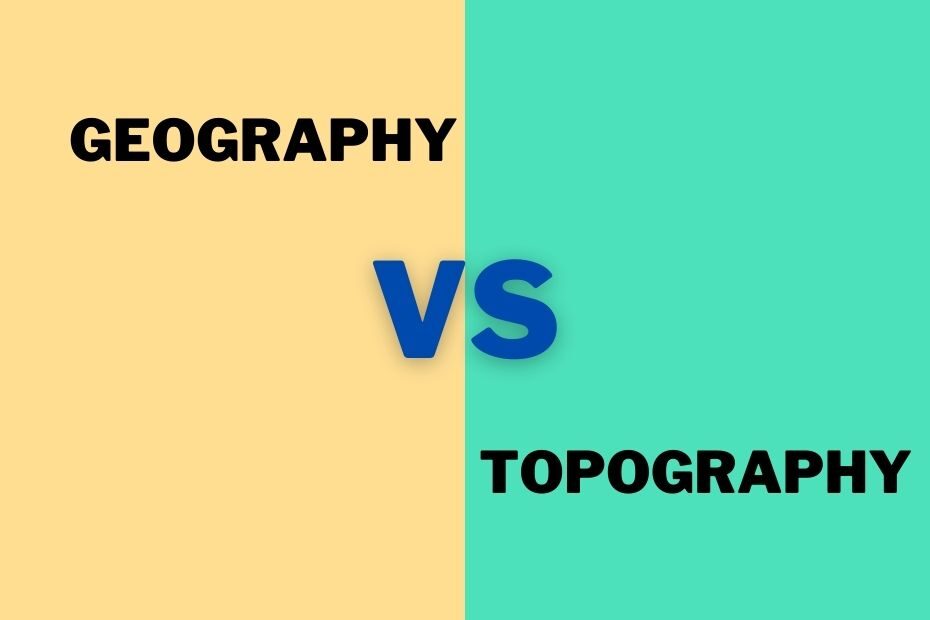Geography and topography are two terms that we often hear in the news or in geography classes. However, we don’t often stop to think about what’s the Difference between Geography and Topography?
Geography Vs Topography
Geography and topography are two very common terms that are often used interchangeably, but they actually refer to two different things.
Geography is the study of the earth’s surface, oceans, islands, and other natural features; the topography is the study of Earth’s physical features or the mapping of these features. Topography maps are one of the most important pieces to understanding geography because they show what type of terrains exist on our planet.
Geography is the study of the earth’s natural divisions and features that affect human beings, such as rivers, mountains, and other natural features. Topography is a term used to describe the elevation of a geographical region.
Geographers examine how different geographical features affect man-made structures, such as roads. One big difference between the two is that topography often focuses on these man-made structures while geography analyzes those aspects from a broader perspective.
Is Topography Similar To Geography?
The importance of topography is often overlooked in the study of our surroundings, but in reality, it plays a huge role. Topography is the measurement and study of the physical shape of the Earth’s surface. It can be used to predict weather patterns, erosion rates, and other aspects of our planet that are important for everyday life.
Many people do not even realize that topography influences their daily lives because they don’t realize how it works. A question that many individuals ask themselves is whether geography and topography are similar. The topography includes the physical relief of a place such as mountains, valleys, plains, and deserts. Topography can also include man-made structures such as buildings and roads. Geography is the study of mapping different places on Earth’s surface such as oceans, landmasses, and rivers. It covers the distribution of natural features including animals, plants, soil type, climate zones, etc.
Is Topography Part of Geography?
The topography of a region is the physical features of a place. A geographer will study these features, such as mountain ranges and valleys, to determine if they are part of the landscape.
But how do we know what is part of the landscape? That is where topography’s role in geology comes into play. The topography includes more than just the surface of the earth. It also includes natural elements on the surface, including water, vegetation and minerals.
Is Topography Part of Geography? This question has been debated for decades. Some people believe that topography is a part of geography, while others say it is not. Whether or not topography should be considered a part of geography does not change the fact that it can have a large impact on the environment and how people live.
In many parts of the world, topographic features such as mountains, hills, valleys, and plains make up the natural landscape. In many cases, these topographic features can completely change the climate of an area. For instance, in many parts of the world, the mountains cause the air to cool, as they have a higher elevation than the surrounding areas. Since the elevation is higher than the surrounding areas, air from the surrounding areas sinks, allowing for cooler temperatures. In many parts of the world, the mountains create wind currents. These wind currents cause the air to take the path of least resistance and flow toward the mountains.
What is the Difference Between Geography and Topography?
Geography is the study of Earth’s surface, features and inhabitants. Geographers also study how people use land and natural resources around them. They examine things like climate, population density, and natural resources distribution.
Topography is a term used to describe physical features on Earth’s surface such as mountains, valleys, plains and rivers. It is also used to describe the location of buildings on a map or on an aerial photo for example.
The main difference between geography and topography is that geographers focus more on human interactions with the environment while topographers focus more on the physical features of the earth.
Comparison between Geography and Topography:
Terms | Geography | Topography |
Definitions | Geography is the study of the Earth's surface and the humans and physical features on it. Geography is a broad field of study that includes everything from natural sciences to social sciences. Geographers are interested in how people interact with their environment, how they use it, and how they change it. Geographers also study how people move around on the Earth's surface, where they live, and why they live there. | Topography is the study of the shape and features of surface. Topography can be used to describe any natural or man-made feature on Earth's surface, including mountains, valleys, rivers, and even buildings. |
Scope | Earth | Any Land, Earth or Any Planet |
Study Area | Study of the Earth Features | Shape of land, including relief and terrain |
Related Terms | Geographer, Geographic, Geographical | Topographer, Topographic, Topographical |
Conclusion:
In conclusion, the difference between geography and topography is that geography deals with the physical features of Earth, while topography deals with the relief or surface variations of the Earth. Geographers are typically more focused on understanding humans- their interactions with other humans and their environment, while topographers are more interested in understanding landscape changes over time.
